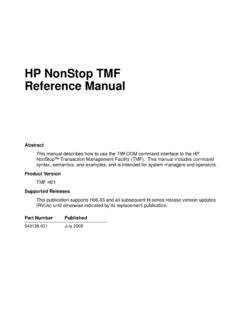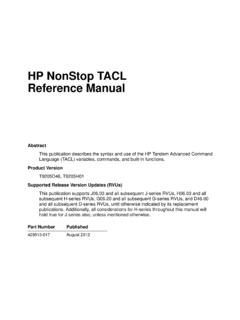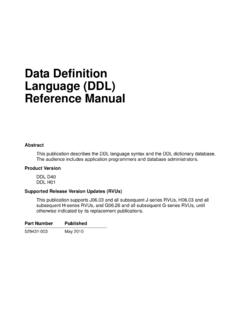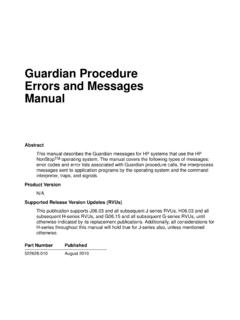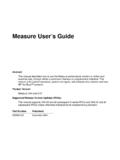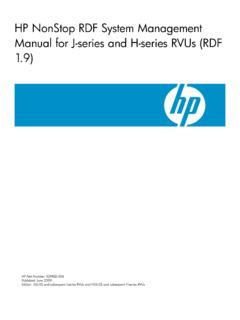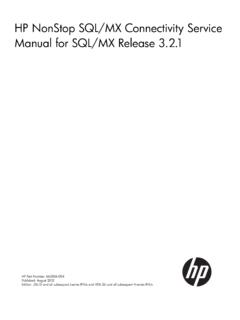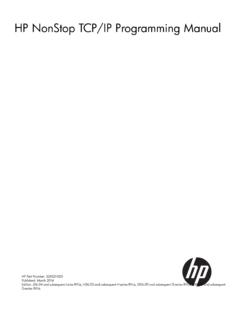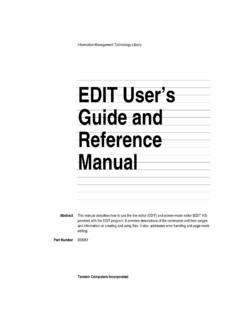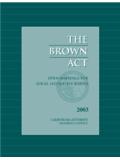Transcription of SCF Reference Manual for SCP - NonStopTools
1 Networking and Data Communications LibraryTandem Computers IncorporatedSCF ReferenceManual for SCPA bstractThis Manual describes the SCF commands used to configure, control, and inquire about the SCPdata-communications Number18098 Document HistoryEditionPart NumberProduct VersionOperating System Version DateFirst Edition18098 SCF C20, SCP C20 GUARDIAN 90 C20 March 1989 New editions incorporate any updates issued since the previous rights reserved. No part of this document may be reproduced in any form, including photocopying ortranslation to another language, without the prior written consent of Tandem Computers 1989 Tandem Computers Incorporated. CONTENTS PREFACE .. v NOTATION CONVENTIONS .. vii SECTION 1. INTRODUCTION .. 1-1 Object Types and Object Names .. 1-1 SECTION 2. SCP PROCESS COMMANDS.
2 2-1 ABORT Command .. 2-2 INFO Command .. 2-3 LISTOPENS Command .. 2-5 PRIMARY Command .. 2-7 START Command .. 2-8 STATUS Command .. 2-9 STOP Command .. 2-11 TRACE Command .. 2-12 VERSION Command .. 2-13 APPENDIX A. COMMAND SUMMARY .. A-1 APPENDIX B. ERROR MESSAGES .. B-1 INDEX .. Index-1 iii NOTATION CONVENTIONS The following list summarizes the conventions for syntax notation in this Manual . Notation Meaning UPPERCASE Uppercase letters represent keywords and reserved LETTERS words; enter these items exactly as shown. italics Lowercase italic letters represent variable items that you supply.
3 Brackets [] Brackets enclose optional syntax items. A group of vertically aligned items enclosed in brackets represents a list of selections from which you can choose one or none. Braces {} Braces enclose required syntax items. A group of vertically aligned items enclosed in braces represents a list of selections from which you must choose one. Vertical A vertical line separates alternative syntax items line | in a horizontal list. Such a list, enclosed in either braces or brackets, is an alternative to a vertical list for presenting selections. Ellipsis An ellipsis immediately following a pair of brackets .. or braces indicates that you can repeat the enclosed syntax items any number of times.
4 Percent A percent sign precedes a number that is not in sign % decimal notation. % indicates octal notation. %B indicates binary notation. %H indicates hexadecimal notation. (%D at the end of a hexadecimal value denotes double precision. %F at the end of a hexadecimal value denotes a fixed numeric constant.) I/O In procedure calls, input parameters (those passing data to the called procedure) are followed by an I; output parameters (those that return data to the calling program) are followed by an O. Spaces If a space separates two items, that space is required. If one of the items is a punctuation symbol, such as a parenthesis or a comma, spaces are optional.
5 Punctuation Parentheses, commas, semicolons, and other symbols not described above must be entered precisely as shown. Quotation marks around any symbol indicate that it is not a syntax descriptor but a required character, and you must enter it as shown. vii PREFACE This Manual describes the Subsystem Control Facility (SCF) interactive interface that allows operators and network managers to configure and control an SCP process. SCF also provides means for examining the configuration and status of an SCP process. SCF is similar in use and function to CMI, described in the Communications Management Interface (CMI) Operator's Guide. CMI is used to configure and control the subsystems described in the CMI Manual ; SCF is used to configure and control the subsystem described in this Manual .
6 The Subsystem Control Point (SCP) is used as the interface between SCF and the data-communications subsystems. SCP is described in the Communications Management Programming Manual ; the interactive interface to the SCP process, SCF, is described here. This Manual is written for operators and network managers. It provides the subsystem-specific information concerning the SCP product. Section 1, "Introduction," gives an overview of SCP, and de- scribes the objects on which it operates. Section 2, "SCP Commands," describes the syntax and action of the SCP commands. Appendix A, "Command Summary," contains a summary of the syntax of the SCP commands. Appendix B, "Error Messages," describes the error messages issued by the SCP process. v PREFACE Before reading this book, you should be familiar with the Reference manuals that describe the data-communications subsys- tems available at your installation.
7 You should also be familiar with the System Generation Manual ; it explains system configuration and SYSGEN. Other GUARDIAN 90 manuals are referred to occasionally in this Manual for detailed information on particular topics. The following publications might be of interest: Introduction to Tandem Computer Systems Introduction to Tandem Data Communications Introduction to Distributed Systems Management (DSM) Communications Management Programming Manual Distributed Systems Management (DSM) Programming Manual Event Management Service (EMS) Manual Distributed Name Service (DNS) Manual Subsystem Control Facility (SCF) Reference Manual SCF Reference Manual for AM3270 and TR3271 SCF Reference Manual for EXPAND SCF Reference Manual for GDS SCF Reference Manual for MULTILAN/TLAM SCF Reference Manual for SNAX/SF SCF Reference Manual for Tandem OSI/AS SCF Reference Manual for Tandem OSI/TS SCF Reference Manual for X25AM vi SECTION 1 INTRODUCTION This Manual describes the subsystem-specific details for using the Subsystem Control Facility (SCF) to control and inquire about the SCP process.
8 To use SCF to control or inquire about SCP, the SCP process must first be running as described in the Communications Management Programming Manual . For information about the role of SCP as an interface between SCF and other data-communications subsystems, refer to the Communications Management Programming Manual and the Subsystem Control Facility (SCF) Reference Manual . OBJECT TYPES AND OBJECT NAMES The SCP process supports two object types--PROCESS and null. If you use the null object type (that is, if you omit the PROCESS object type when you enter a command), the PROCESS object type is assumed. The PROCESS object name identifies a specific SCP process. The object name follows GUARDIAN 90 naming conventions. Usually, the SCP object process is named $ZNET. Use the command LISTDEV SCP to obtain a list of SCP process names on your system.
9 1-1 SECTION 2 SCP PROCESS COMMANDS The SCF commands and their modifiers that apply to SCP are described in this section. SCP supports the following commands: Sensitive Commands Nonsensitive Commands ABORT INFO PRIMARY LISTOPENS START STATUS STOP VERSION TRACE For information about TRACE commands applied to other subsystems, see the relevant subsystem description. The TRACE command described in this section applies only to SCP. The syntax for the commands is shown in Appendix A. Detailed syntax information for these commands is provided when you type the following SCF command: HELP SCP [ command-name ] 2-1 SCP PROCESS COMMANDS ABORT Command ABORT COMMAND The ABORT command terminates the operation of the SCP process as quickly as possible--only enough processing is done to ensure the security of the subsystem.
10 The SCP process is left in the STOPPED state. This is a sensitive command. The SUB and SEL options are not supported for the ABORT command. The ABORT command has the following object-spec: object-type object-name PROCESS SCP-process-name Examples ABORT $ZNET 2-2 SCP PROCESS COMMANDS INFO Command INFO COMMAND The INFO command displays the current or default attribute values for the specified SCP process. The DETAIL, SUB, and SEL options are not supported for the INFO command. The INFO command has the following object-spec: object-type object-name PROCESS SCP-process-name The display for the INFO command has the following format: Display SCP Info Process Name Autostop Delay Spage Program aaaaaaaa bbbbbbbb cccccccc ddd eeeeeeee Explanation of Symbols aaaaaaaa is the SCP process name.
